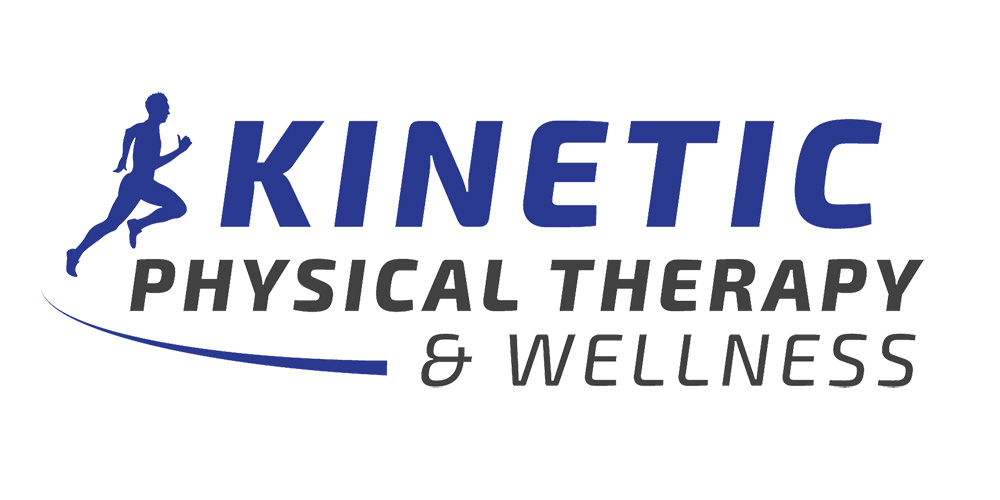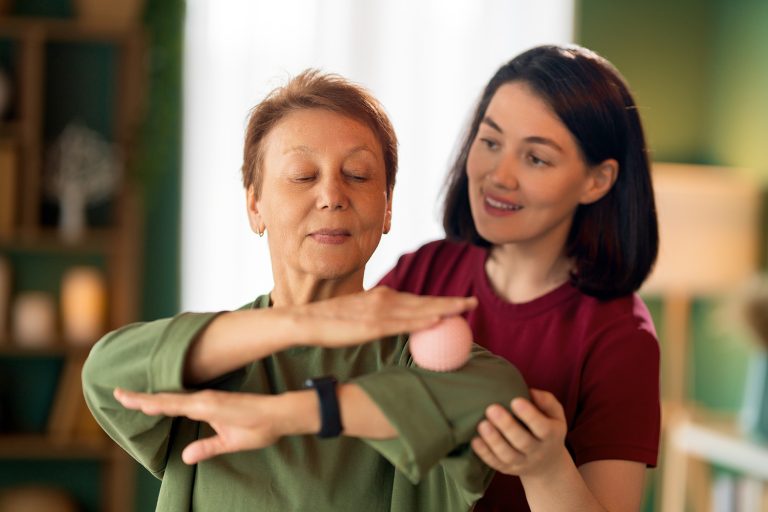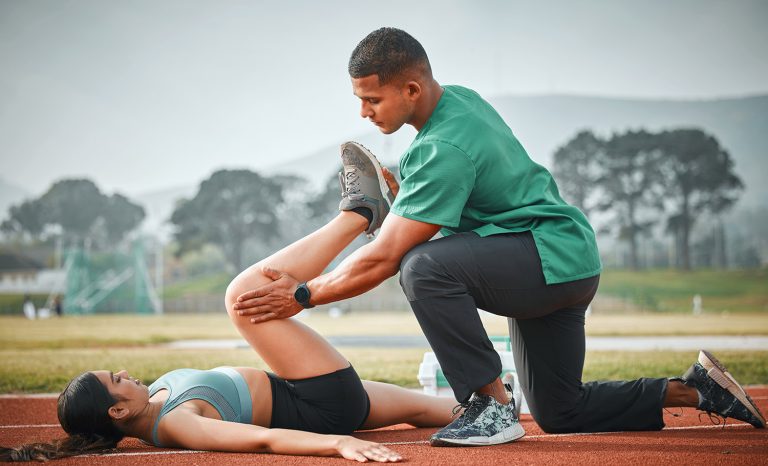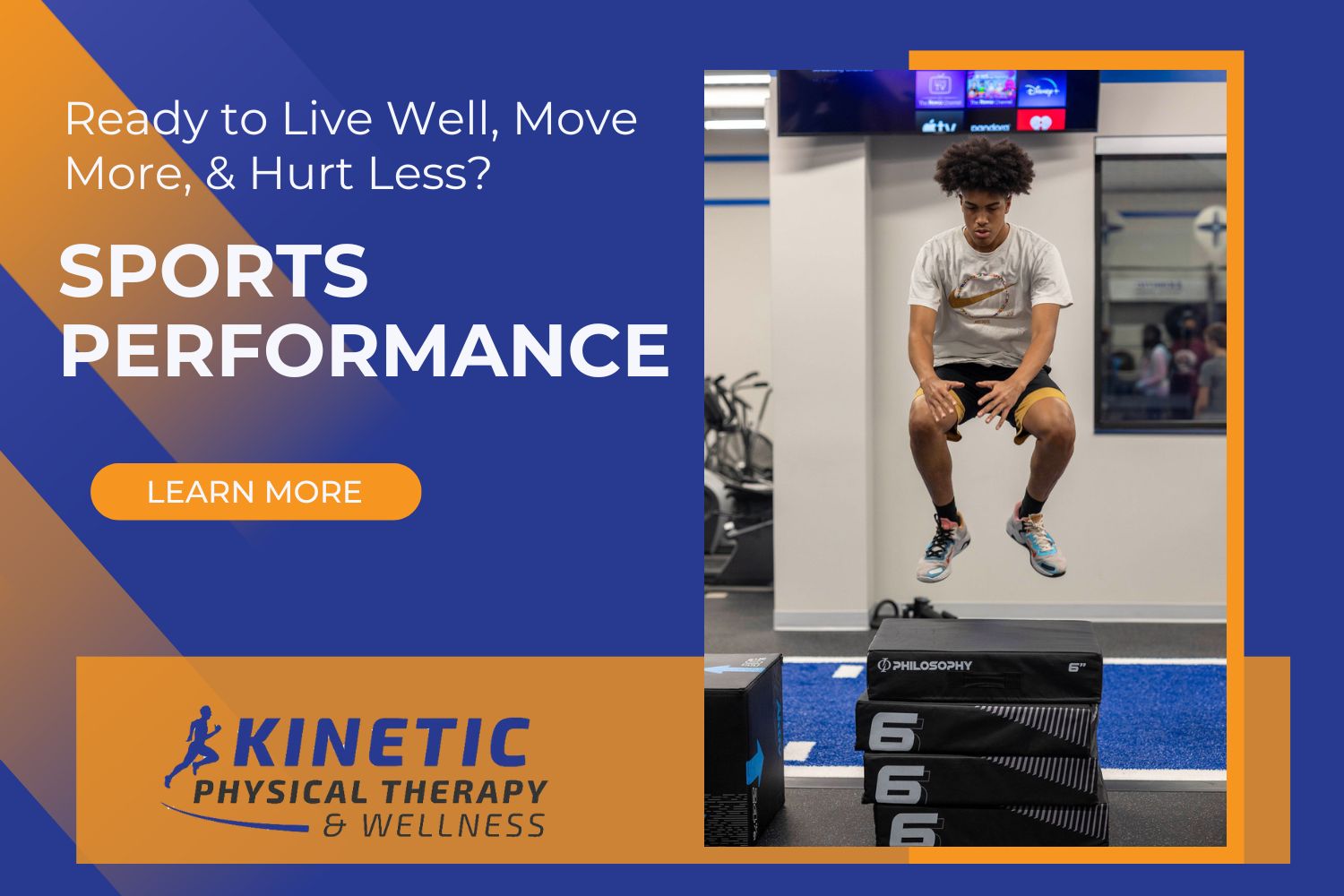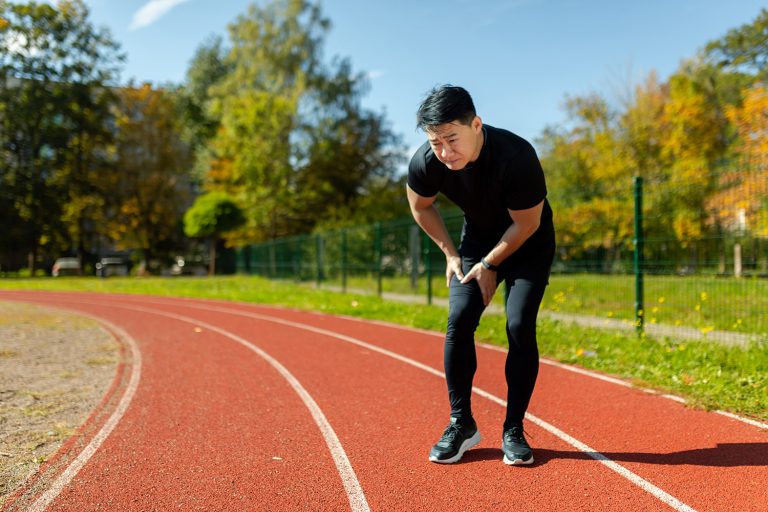

Sport-Specific Plyometrics
Drills that Boost Power Without Injuries
Athletes looking to gain explosive power, improve agility, and enhance their performance can benefit greatly from integrating sport-specific plyometrics into their training routines. These exercises focus on quick, powerful movements that mimic the demands of a particular sport, helping athletes develop the strength and coordination necessary for peak performance. Unlike generic jump training, sport-specific plyometrics are tailored to the movement patterns, speed requirements, and force demands of the athlete’s sport, making them highly effective for skill transfer. At Kinetic Physical Therapy and Wellness, these drills are strategically incorporated into personalized sports performance programs to ensure athletes maximize their power output while minimizing the risk of injury.
The Science Behind Sport-Specific Plyometrics
The goal of sport-specific plyometrics is to train the stretch-shortening cycle of the muscles, which is the rapid transition from muscle lengthening to shortening during explosive movements. This cycle is crucial for actions like sprinting, jumping, and changing direction. By training the neuromuscular system to produce force quickly, athletes can improve their reaction time, acceleration, and overall performance. When these exercises are adapted to the movements of a specific sport, they provide direct performance benefits on the field, court, or track. Integrating them into a structured sports performance plan ensures the training is both effective and safe.
Why Sport-Specific Plyometrics Reduce Injury Risk
A common misconception about plyometric training is that it always carries a high risk of injury. While improper technique or excessive volume can indeed be harmful, well-designed sport-specific plyometrics programs actually help reduce injury risk. These drills strengthen muscles, tendons, and ligaments, improve joint stability, and enhance coordination. By mimicking sport movements under controlled conditions, athletes build resilience in the exact patterns they will use during competition. This targeted preparation helps prevent overuse injuries and ensures the body is ready for the physical demands of the sport.
Examples of Sport-Specific Plyometric Drills
At Kinetic Physical Therapy and Wellness, sport-specific plyometrics are customized to the athlete’s sport and skill level. Some examples include:
- For basketball players: Depth jumps followed by a sprint to simulate rebounding and fast breaks
- For soccer players: Lateral hurdle hops combined with quick directional changes to mimic defensive positioning
- For volleyball players: Single-leg box jumps to replicate take-off for spikes and blocks
- For football players: Broad jumps into sprint starts to build explosive acceleration off the line
- For tennis players: Side-to-side bounds to improve lateral court coverage
These drills are carefully integrated into sports performance programs, ensuring they align with the athlete’s competitive needs and fitness level.
How to Progress in Sport-Specific Plyometrics
Progression in sport-specific plyometrics should be gradual to avoid injury and ensure consistent improvement. Athletes typically begin with basic plyometric movements, focusing on proper landing mechanics and stability. As strength and technique improve, more complex, explosive, and sport-specific variations are introduced. Factors like jump height, speed, direction, and reactive elements can be adjusted to match the athlete’s evolving abilities. A progressive approach ensures that gains in power translate effectively to real-game situations while maintaining long-term physical health.
The Role of Technique in Plyometric Training
The effectiveness of sport-specific plyometrics relies heavily on proper form and execution. Incorrect technique not only limits performance gains but also increases injury risk. Athletes must focus on landing softly, engaging the core, and maintaining alignment during each movement. Professional coaching ensures exercises are executed with precision, reinforcing correct movement patterns and maximizing benefits. Within our sports performance training, technique is prioritized to produce powerful yet controlled movements that translate to competition.
Integrating Plyometrics into a Comprehensive Training Program
While sport-specific plyometrics are highly effective, they should not be the sole component of an athlete’s training. They work best when combined with strength training, mobility exercises, and sport skill development. Plyometrics should be strategically placed in the training schedule, often performed early in a session when the athlete is fresh to ensure maximum explosive output. This integration ensures a balanced approach that enhances overall sports performance without overloading the body.
Sport-Specific Plyometrics for Different Athlete Levels
Not all athletes require the same intensity or volume of Sport-Specific Plyometrics. Beginners should start with low-impact variations, such as squat jumps or low box step-offs, to build foundational strength. Intermediate athletes can progress to moderate-intensity drills with added resistance or reactive elements. Advanced athletes may perform high-intensity, multi-directional plyometrics that closely simulate in-game demands. Tailoring exercises to the athlete’s current level ensures safety and optimal development within their sports performance program.
Measuring Progress in Plyometric Training
To ensure sport-specific plyometrics are delivering results, performance metrics should be tracked regularly. Measurements can include vertical jump height, sprint times, or agility test results. Tracking improvements not only motivates athletes but also allows coaches to adjust training variables for continued progress. This data-driven approach is a core element of our sports performance philosophy, helping athletes achieve measurable, long-term results.
Achieve Explosive Power with Sport-Specific Plyometrics
When designed and executed correctly, sport-specific plyometrics are one of the most effective ways to build sport-ready power without compromising safety. By targeting the exact movements and energy systems required for competition, these drills enhance performance while protecting the athlete’s body. At Kinetic Physical Therapy and Wellness, our personalized sports performance programs ensure that plyometric training is safe, effective, and directly transferable to the demands of your sport. Contact us today to start developing explosive power that will set you apart from the competition.
Ready to elevate your athletic performance? Unlock your full potential with the Sports Performance Program at Kinetic Physical Therapy and Wellness in Greenville, NC! Our expert trainers provide personalized, science-backed training designed to enhance your strength, speed, and agility. Whether you’re a seasoned athlete or just starting out, our program is tailored to help you achieve your specific goals and excel in your sport. Don’t just play—perform at your best! Sign up for our Sports Performance Program today and take your game to the next level!
Please Share
categories
Recent Posts

Sport-Specific Plyometrics
Drills that Boost Power Without Injuries
Athletes looking to gain explosive power, improve agility, and enhance their performance can benefit greatly from integrating sport-specific plyometrics into their training routines. These exercises focus on quick, powerful movements that mimic the demands of a particular sport, helping athletes develop the strength and coordination necessary for peak performance. Unlike generic jump training, sport-specific plyometrics are tailored to the movement patterns, speed requirements, and force demands of the athlete’s sport, making them highly effective for skill transfer. At Kinetic Physical Therapy and Wellness, these drills are strategically incorporated into personalized sports performance programs to ensure athletes maximize their power output while minimizing the risk of injury.
The Science Behind Sport-Specific Plyometrics
The goal of sport-specific plyometrics is to train the stretch-shortening cycle of the muscles, which is the rapid transition from muscle lengthening to shortening during explosive movements. This cycle is crucial for actions like sprinting, jumping, and changing direction. By training the neuromuscular system to produce force quickly, athletes can improve their reaction time, acceleration, and overall performance. When these exercises are adapted to the movements of a specific sport, they provide direct performance benefits on the field, court, or track. Integrating them into a structured sports performance plan ensures the training is both effective and safe.
Why Sport-Specific Plyometrics Reduce Injury Risk
A common misconception about plyometric training is that it always carries a high risk of injury. While improper technique or excessive volume can indeed be harmful, well-designed sport-specific plyometrics programs actually help reduce injury risk. These drills strengthen muscles, tendons, and ligaments, improve joint stability, and enhance coordination. By mimicking sport movements under controlled conditions, athletes build resilience in the exact patterns they will use during competition. This targeted preparation helps prevent overuse injuries and ensures the body is ready for the physical demands of the sport.
Examples of Sport-Specific Plyometric Drills
At Kinetic Physical Therapy and Wellness, sport-specific plyometrics are customized to the athlete’s sport and skill level. Some examples include:
- For basketball players: Depth jumps followed by a sprint to simulate rebounding and fast breaks
- For soccer players: Lateral hurdle hops combined with quick directional changes to mimic defensive positioning
- For volleyball players: Single-leg box jumps to replicate take-off for spikes and blocks
- For football players: Broad jumps into sprint starts to build explosive acceleration off the line
- For tennis players: Side-to-side bounds to improve lateral court coverage
These drills are carefully integrated into sports performance programs, ensuring they align with the athlete’s competitive needs and fitness level.
How to Progress in Sport-Specific Plyometrics
Progression in sport-specific plyometrics should be gradual to avoid injury and ensure consistent improvement. Athletes typically begin with basic plyometric movements, focusing on proper landing mechanics and stability. As strength and technique improve, more complex, explosive, and sport-specific variations are introduced. Factors like jump height, speed, direction, and reactive elements can be adjusted to match the athlete’s evolving abilities. A progressive approach ensures that gains in power translate effectively to real-game situations while maintaining long-term physical health.
The Role of Technique in Plyometric Training
The effectiveness of sport-specific plyometrics relies heavily on proper form and execution. Incorrect technique not only limits performance gains but also increases injury risk. Athletes must focus on landing softly, engaging the core, and maintaining alignment during each movement. Professional coaching ensures exercises are executed with precision, reinforcing correct movement patterns and maximizing benefits. Within our sports performance training, technique is prioritized to produce powerful yet controlled movements that translate to competition.
Integrating Plyometrics into a Comprehensive Training Program
While sport-specific plyometrics are highly effective, they should not be the sole component of an athlete’s training. They work best when combined with strength training, mobility exercises, and sport skill development. Plyometrics should be strategically placed in the training schedule, often performed early in a session when the athlete is fresh to ensure maximum explosive output. This integration ensures a balanced approach that enhances overall sports performance without overloading the body.
Sport-Specific Plyometrics for Different Athlete Levels
Not all athletes require the same intensity or volume of Sport-Specific Plyometrics. Beginners should start with low-impact variations, such as squat jumps or low box step-offs, to build foundational strength. Intermediate athletes can progress to moderate-intensity drills with added resistance or reactive elements. Advanced athletes may perform high-intensity, multi-directional plyometrics that closely simulate in-game demands. Tailoring exercises to the athlete’s current level ensures safety and optimal development within their sports performance program.
Measuring Progress in Plyometric Training
To ensure sport-specific plyometrics are delivering results, performance metrics should be tracked regularly. Measurements can include vertical jump height, sprint times, or agility test results. Tracking improvements not only motivates athletes but also allows coaches to adjust training variables for continued progress. This data-driven approach is a core element of our sports performance philosophy, helping athletes achieve measurable, long-term results.
Achieve Explosive Power with Sport-Specific Plyometrics
When designed and executed correctly, sport-specific plyometrics are one of the most effective ways to build sport-ready power without compromising safety. By targeting the exact movements and energy systems required for competition, these drills enhance performance while protecting the athlete’s body. At Kinetic Physical Therapy and Wellness, our personalized sports performance programs ensure that plyometric training is safe, effective, and directly transferable to the demands of your sport. Contact us today to start developing explosive power that will set you apart from the competition.
Ready to elevate your athletic performance? Unlock your full potential with the Sports Performance Program at Kinetic Physical Therapy and Wellness in Greenville, NC! Our expert trainers provide personalized, science-backed training designed to enhance your strength, speed, and agility. Whether you’re a seasoned athlete or just starting out, our program is tailored to help you achieve your specific goals and excel in your sport. Don’t just play—perform at your best! Sign up for our Sports Performance Program today and take your game to the next level!
Please Share
